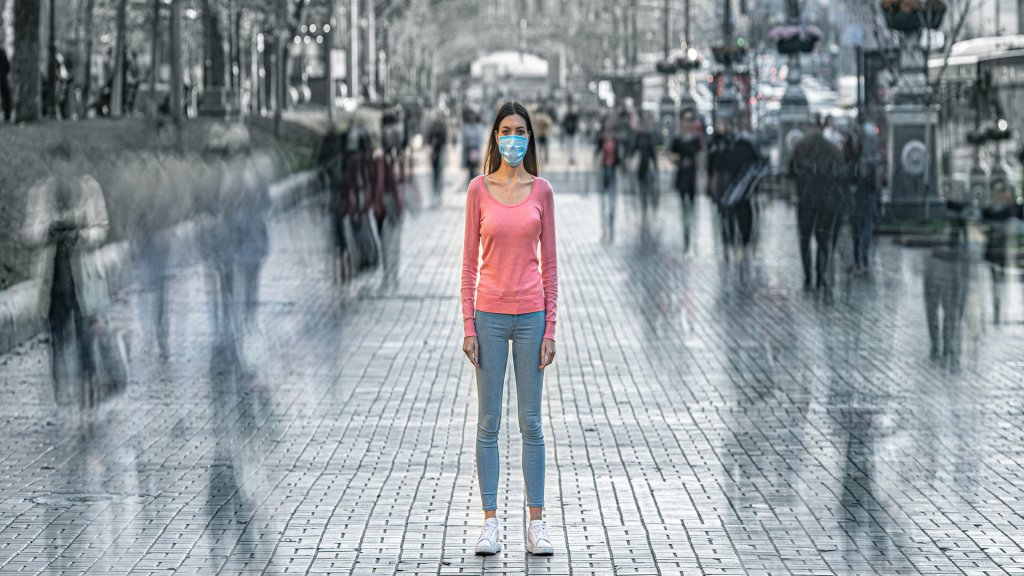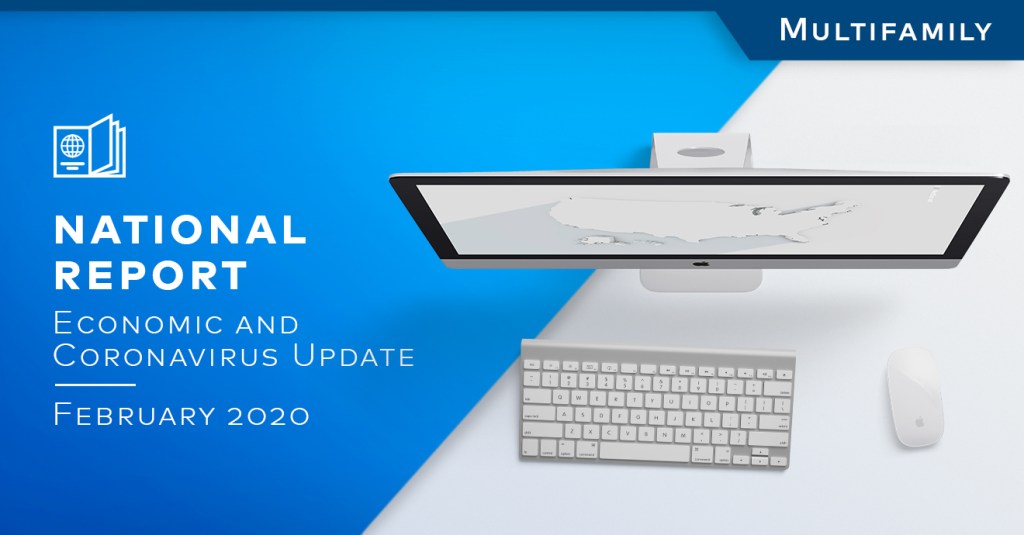As multifamily real estate continues to adapt to new standards of social distancing and uncertain economic times, a longtime asset management executive sees signs of positive momentum for the industry. Greg Slang is executive vice president of asset management at KETTLER, a national recognized developer/owner/operator of multifamily assets in the Washington D.C. region as well as Florida and the Carolinas. With a portfolio that includes apartments in all asset classes from affordable to A+, Slang is positioned to observe the impact of the COVID-19 pandemic across property types and resident experiences. He recently sat down for an interview with Dhar Sawh, industry principal at Yardi, to speak about multifamily’s adaption to the changing times and KETTLER’s particularly swift response. You can listen to the full commentary here. Having worked through 9/11 and the Great Recession of 2007-2008, Slang provided an insightful look at the state of the multifamily industry from an asset management perspective. Among the topics covered in his interview: remote work, resident considerations during COVID-19, and what to look out for next. “This all happened very quickly,” said Slang. “It has been very difficult from a shock perspective. I liken it to 9/11, where one day all seems to be fine, and the next day, the whole world seems to be thrown into disarray.” Multifamily has reacted quickly to the social distancing circumstances required by COVID-19, incorporating the use of virtual tours, online leasing and other proactive measures. The only things that truly can’t be resolved remotely are major maintenance concerns. Slang said that the KETTLER team has reacted well to working remotely and is continuing to serve their residents effectively from a safe distance. That may be the norm in the months to come, he noted. “We were very surprised at...
Price is Right?
Revenue Management Now
Are you thinking about fine tuning your revenue management program to meet the challenges of COVID-19? The current market is impacting demand and pricing, and it’s time to consider new strategies for managing your assets with both a short- and long-term focus on collections and occupancy. As some states are already planning to open up within phased approach guidelines, Yardi Matrix data shows that demand is bouncing back from an initial drop of about 30% during the first two weeks of March. Plus, move-outs have slowed down. Looking at data collected from 11.5 million apartment units, April collections were better than expected according to the NMHC Rent Payment Tracker which showed 84% of apartment households made full or partial rent payments by April 12 and 91.5% by April 26. While that’s good news, the coming months are a bit unpredictable due to growing unemployment and delays for many people in getting their benefit payments. “It is encouraging that apartment residents continue to meet their rent obligations whether that’s with the support of the federal relief funds, credit cards and alternative, flexible options provided by the industry’s owners and operators,” said NMHC President Doug Bibby. “But their financial security is unclear as many may not qualify for federal relief, while others are drawing down savings and facing greater financial challenges, including higher health care costs. For that reason, lawmakers need to act now to enact a direct renter assistance program.”* One growing trend is undeniable: leasing has shifted online, so be ready to handle more virtual traffic to your properties. Your revenue management strategy should adapt smartly to these changes in demand and interactions. Many initially thought a lockdown on rental pricing increases made sense but could be a knee-jerk reaction. There’s more to...
Leaving Cities
Weighing options due to COVID-19
Anabelle Strauss grew to love the Mission District of San Francisco. As a data scientist, she enjoys the balance of living in a neighborhood of creatives. Her apartment is nestled amid an array of local grocers, international restaurants, and small businesses that are also appealing. But as COVID-19 swept through the city, much of what she loved about the area changed. Her tech job allowed her to work comfortably from home two weeks before the governor issued a shelter in place edict. But then the local shops closed, some temporarily while others were less fortunate. Her cozy apartment began to feel claustrophic. She yearned for outdoor access that she didn’t have. What’s worst, she felt that the shared ventilation system in the apartment building caused her illness. “I was sick for a while, likely COVID,” Strauss says casually. “All the neighbors coughing constantly, I think I contracted it inside the apartment. It was a milder form, so it wasn’t that bad, but it affects my cognitive ability and there is lung pain. It’s been one-and-a-half months now.” Now Strauss, like many other Americans, is looking to escape the congestion on urban life. Her interview took place over the phone as she drove to the suburbs to tour a single family home. “A detached home would be nice. The more detached the better,” she laughs. “It would be very nice to get some outdoor space.” The quiet exodus The transition from cities to suburbs has been happening quietly for years now. The COVID-19 pandemic shined a light on the shift and brought a few newcomers onto the moving truck. Many wonder, though, if the suburbs create a false sense of safety. It’s a misconception supported by legislators nationwide. New York Gov. Andrew Cuomo has accused density of spreading the virus more rapidly. “Why are we seeing this level of infection? Well, why cities across the country?” he asked reporters during a news briefing. “It’s about density. It’s about the number of people in a small geographic location allowing that virus to spread. … Dense environments are its feeding grounds.” In an effort to not be consumed by the respiratory infection, those who can seek refuge in less densely populated towns are doing so. Austin, Nashville, Asheville, and a spattering of towns in Texas and South Florida have experienced a spike in new residents. The problem: research doesn’t support the theory that densely populated cities increase the likelihood of illness. The facts: policy—not space—protects residents Some of the most densely populated cities in the world have successful mitigated COVID-19 spread. Decisive, proactive policy coupled with community adherence has led to success in ways that space alone cannot. Tokyo, Vancouver, and Seoul exemplify that population density does not correlate to an increase risk of illness. Vancouver, which is more densely populated than New York, has had a fraction of the illnesses and deaths per capita, reports Joe Cortright, director of The City Observatory in New York. Conversely, less populated areas like Cynthiana, Kentucky and Fairfax County, Virginia have a disproportionately high number of cases per capita. “I think that’s one of the lessons here: With information and smart policy, there’s no reason why cities are inherently going to be hit harder,” observes Cortright. So why are people still leaving the cities? While less populated towns can’t offer refuge from a pandemic, people like Strauss still want to leave the cities for the sake of their mental health. “Even before COVID, all the face-to-face time in the city extracts energy. It takes a toll. It’s draining,” she says. “And the neighborhood that I live in, I think it’s becoming more dangerous. Those are other reasons to look for something new. And I think I may just like more space, more green space, if the price makes sense.” Strauss plans take her tech job with her to her new location. COVID-19 highlights just...
What’s Ahead for Energy
2020 and Beyond
The U.S. Energy Information Administration, the U.S. Department of Energy’s statistical and analytical agency, provides annual projections for U.S. and world energy markets over the next 30 years. Highlights from the latest release: Overall U.S. energy consumption will grow more slowly than gross domestic product as energy efficiency continues to increase. Purchased electricity consumption will increase by 0.6% and 0.8% annually in the residential and commercial sectors, respectively, due to increased demand for electricity-using appliances, devices and equipment. In 2019, 44% of residential light bulbs were LEDs, the most efficient light bulb technology available, and 17% of commercial lighting service demand was met by LED bulbs and fixtures. By 2050, these shares will reach 90% and 88%, respectively. Energy-related CO2 emissions decrease initially then rise closer to 2050 as economic growth and increasing energy demand outweigh improvements in efficiency. After initially falling, total U.S. energy-related CO2 emissions will grow modestly in the 2030s, driven largely by increases in energy demand in the transportation and industrial sectors. Emissions in 2050 will still be 4% lower than 2019 levels. Increases in fuel economy standards will drive a 19% decrease in U.S. motor gasoline consumption through 2050. The U.S. will continue to export more petroleum and other liquids than it imports as domestic crude oil production continues to increase and domestic consumption of petroleum products decreases. Renewables/biofuels Renewables will be the fastest-growing source of electricity generation due to continuing declines in solar and wind capital costs coupled with federal tax credits and higher state-level targets. Total renewable generation will exceed natural gas-fired generation after 2045. Without distributed generation sources, particularly rooftop solar, electricity consumption in residential and commercial buildings would be 5% and 3% higher, respectively, by 2050. Generation from renewable sources will rise from 18% of total generation in 2018 to 38%. Solar photovoltaic (PV) will contribute the most to the growth in total renewable generation, increasing from 13% in 2018 to 46%. Although onshore wind generation will more than double, its share of renewable generation will go from 37% to 29%. The U.S. will add 117 gigawatts of new wind and solar capacity between 2020 and 2023. Electricity is the fastest-growing energy source in the transportation sector, increasing by an average of 7.4% per year as a result of increased demand for electric light-duty vehicles. While gasoline vehicles will remain the dominant vehicle type through 2050, the combined share of sales from gasoline and flex-fuel vehicles (which use gasoline blended with up to 85% ethanol) declines from 94% in 2019 to 81% because of growth in sales of battery electric vehicles, plug-in hybrid electric vehicles and hybrid electric vehicles. The percentage of biofuels (ethanol, biodiesel, renewable diesel, and biobutanol) blended into U.S. gasoline, diesel, and jet fuel will increase from 7.3% in 2019 to 9% in 2040. Commercial and industrial space Total delivered energy consumption in the U.S. buildings sector will grow by 0.2% annually as energy efficiency improvements, increased distributed electricity generation and regional shifts in the population partially offset the impacts of higher growth rates in population, number of households and commercial floor space. Lower costs and energy efficiency incentives will result in efficient LEDs displacing linear fluorescent lighting as the dominant commercial lighting technology by 2030. Commercial PV capacity will increase by an annual average of 3.4%. Residential space S. total delivered residential energy intensity, defined as annual delivered energy use per household, will fall by 17% between 2019 and 2050 as the number of households grows faster than energy use. Factors contributing to this decline include gains in appliance efficiency, onsite electricity generation (e.g., solar photovoltaic), utility energy efficiency rebates, rising residential natural gas prices, lower space heating demand and population shifts to warmer regions. Residential PV capacity will increase by an average of 6.1% per year, accelerated by rising incomes, declining system costs and social influences. Learn how Yardi software can increase energy efficiency...
Creating Community
Bringing Residents Together Online
Traditionally, creating a sense of community has been a great way to make residents feel at home, leading to positive reviews, referrals and increased renewals. Multifamily properties host happy hours, movie nights and exercise classes to help renters connect with each other and the property team. They create and update shared spaces and amenities to make sure they are comfortable and welcoming. But how do you create a sense of community when people can’t gather? Property managers everywhere are asking this question now because of the social distancing measures put in place during the COVID-19 pandemic. We’re here to help. First, watch a video from our new “Moments of Genius with Drew Davis” series to get creative community building tips you can use right now. Then, see what the award-winning team at Bozzuto is doing. And finally, discover tech tools that can help bring your residents and team members together. 6 Creative Ideas Watch this short, five-minute video from Drew Davis to learn six creative ways and four key principles to foster community at your properties — even when we can’t all be in the same place. Drew is one of the world’s top marketing experts. He is working closely with us to share monthly tips specific to property management as we navigate this rapidly changing market together. Wasn’t that fun and inspiring? Drew is just the shot of positive energy we need right now, and we’re excited to see what he has in store for us. Subscribe to “Moments of Genius” now to see new episodes when they’re released. #BozzutoStaysHome When stay-at-home orders started getting handed down, the team at Bozzuto knew they had to spring into action. “We asked ourselves, ‘How do we continue to provide value to our residents when they can’t use the amenities?’” said Nicole Wells, content marketing manager for digital marketing and strategy at Bozzuto. #BozzutoStaysHome was the result, an online program that connects residents, includes the community and celebrates the idea of sanctuary, ultimately promoting shelter-in-place behaviors to flatten the curve. It includes a calendar of weekly virtual events led by community partners like yoga classes and cooking demonstrations as well as curated playlists designed to lift spirits and nurture a sense of connection. Events are shared live on Facebook and Instagram. Facebook Live events like this Vinyasa yoga class are recorded and shared so anyone can watch anytime, racking up hundreds of views. “To get started, we put together a cross-team task force. We asked our residents what they wanted to see,” shared Wells. Once the concept started coming together, “We created assets for our communities to use so they don’t have to do that extra work themselves. They already have enough to focus on right now.” With more than 400 posts using the hashtag on Instagram in just a few weeks and hundreds of viewers to their live and recorded events, #BozzutoStaysHome is picking up traction. “Bozzuto is helping residents engage in a little bit of fun at home during quarantine,” said Wells. “They’re receptive to that, and we’re happy to be a bright spot.” Tech That Connects People can’t participate in your community engagement efforts if they don’t know about them. In the words of Drew Davis, “Make sure your residents know where to go for the latest information about your property and the fun things you’re doing to keep people safe and connected.” With the RENTCafé resident portal and RENTCafé Resident app, you can quickly and easily share information about social distancing efforts and upcoming online events. You can post events to your community calendar and bulletin board, send survey emails and even schedule push notifications if your residents have opted in on the app. Both the portal and the app help your team stay connected while cutting down on face-to-face interactions by taking communications, payments and work orders online. With a 4.8 star rating and more than...
Gold Diggers
Finding Energy Savings
In 2019, hundreds of organizations including real estate firms used Energy Treasure Hunts to reduce energy use by up to 15 percent and they’re hoping for even more participation in 2020. As explained on the ENERGY STAR® website, Energy Treasure Hunt teams walk around facilities looking for quick ways to save energy. Those fast fixes can add up to big savings, which is like finding buried treasure. Companies from various industries participated in the inaugural year’s Energy Treasure Hunt including AMLI Residential, Bozzuto Management, Colgate, Allergan, Kilroy Realty Corporation, Columbia Association, Boeing, Lockheed Martin and Nissan. For multifamily and commercial real estate operators, the Energy Treasure Hunt checklist, called a Treasure Map, includes a detailed audit of lighting, building envelopes (inspecting all doors and windows for gaps and damage), equipment and plug loads and HVAC systems. Using energy efficient lighting, improving insulation and managing power usage proved to be a few easy ways to save money, and thousands of dollars in potential annual savings were uncovered. Here are some highlights: Kilroy Realty Corporation found a potential annual savings of $20,300. Top savings opportunities identified: Retrofit the exterior lighting in all parking areas Retrofit lighting in all indoor common areas Conduct retro-commissioning For AMLI Residential, the audit revealed a potential annual savings of $7,800. Top savings opportunities identified: Implement checks to ensure correct set points in vacant and common areas Insulate hot water heater supply piping within the HVAC closets Use power management setting on business center and leasing office computers Bozzuto Management Company discovered a potential savings of $10,190. Top savings opportunities identified: Implement LED retrofits Install lighting controls and sensors Establish thermostat setting standardization While identifying precise dollar amounts in potential savings is exciting, even before an Energy Treasure Hunt most companies realize...
Real Estate Design
Pandemic Mitigation in Housing
Shelter in place practices have made an impact on every industry in America. Multitenant industrial and retailers grasp to make rent while grocers, tech, and delivery firms thrive. We naturally attach value to such changes. Real estate and its design, however, are neutral reflectors of social shifts. Like events before it, COVID-19 is the next big thing to change the face of housing. But first, let’s look back at other shifts that have changed the way that we live. We’ve seen this before – sort of Major social and economic events directly impact that way that we design and inhabit real estate. Following the wreckage of the Great Depression, President Franklin D. Roosevelt’s New Deal propelled the development of interstates and suburbs. Subdivisions sprang up, dispersing families into nuclear households. By the mid-1940s, middle class workers’ commutes prompted the addition of built-on garages. With the cheap suburban lots, greater car affordability, and adequate employment rates of the 1960s, many families opted for large houses with two-car garages. Fast forward to the economic prosperity of the 90s. Middle class and affluent Americans indulged in spacious homes with open floor plans. Multifamily construction boomed, answering demand from young adults who struck out on their own. Most formed their own households after graduation. In 2005, only 19% of college graduates lived with or moved back in with their parents, reports MarketWatch. The Great Recession ended lavish living for most Americans. Homeowners and investors struggled with mortgages, inundating the market with foreclosures. As the Great Recession dragged on, multitudes of seniors moved in with their adult kids. The number of recent graduates moving back into their parents’ homes jumped to 28% in 2016. The nuclear households of the 50s-90s began to disappear. Multigenerational housing reemerged and real estate changes followed soon after. Coming full circle to multigenerational housing with a twist Around 2012, multigenerational housing became the “new” trend in single family real estate. Though multigenerational households were the standard for thousands of years, modern multigen housing offered greater privacy. Finished basements with separate entries increased in popularity. Homes with two masters on the main floor thrived since they could support the homeowners as well as their aging parents. In price points that accommodated larger lots, young adults or in-laws lived in detached suites that shared mortgage and utilities costs. Young adults who would not or could not move in with family weathered the hard times in their apartments. Roommate floor plans were hot, especially when equipped with equally-sized private bedrooms and en suite bathrooms. Young adults postponed homeownership. Green building reasserts itself As the world shrugged off the burdens of the Great Recession, many eyes shifted to the next big thing in sustainable housing. Urban infill properties and mixed-use buildings brought residents closer to the businesses and services they used most. As a result, both classes reduced transportation pollution and costs. Between 2010-2019, tiny houses, micro apartments and co-living blossomed as way to reduce housing costs and environmental impact. Inside of their homes, residents implemented artificial technology to promote conservation and cut costs. Smart thermostats, lights, and appliances have become more commonplace. In addition to saving money and resources, residents crave greater control of our homes even when we were outside of it. Little did we know that we be spending so much time at home in 2020. COVID-19: the death of open floor plans? March 2020 marked sweeping shelter in place practices throughout the US. The sustainable measures of the past decade helped to decrease housing expenses, but other real estate changes are being reevaluated. Residents of mixed-use and infill properties are feeling the pain of stay at home policies. Public green spaces are closed and few units have more than a balcony for access to the outdoors. Psychologically, being surrounded by closed businesses isn’t reassuring. Smart home tech comes with benefits and disadvantages during the COVID-19 lockdown. The conveniences that...
Unusual Impacts
Of the COVID-19 crisis
Trash volume at apartment communities during the COVID-19 crisis are showing a 30 percent to 35 percent increase nationally, according to Camden Residential, a REIT that operates 165 properties across the country. Its Director, National Purchasing, Rick Pippin says everything except for cardboard has increased. And although residents are certainly ordering plenty through Amazon, he says, because no one is moving out during this national shelter-in-place environment the residents aren’t generating a noticeable increase in box disposal. His waste haulers typically charge $150 in overage fees each time a bin exceeds the level, but Waste Management, for one, has waived those fees through May in response to the unusual circumstances. “We have as many as 25 bins at some properties,” Pippin says. “This is saving us about $8,000 per week in expense. Waste Management also has not been enforcing some recycling contamination fees, so we’re kind of getting a mulligan on that, too. Every little bit helps.” Camden has trash compactors at 100 of his communities, so overage is not an issue for those. But for the other properties, his residents and onsite trash-pickup service providers, who provide doorstep trash pick-up five or six or times a week, he says he’s seeing overflow in the bins nearest to the buildings. “The bins way in the back of the lot aren’t seeing waste piled as high,” Pippin says. “I’m fighting with those who carry the trash to the bins to even it out, telling them to walk a bit further before dumping, but there’s only so much you can do.” Camden uses Waste Management at 70 percent of its communities, and uses Republic, among others, elsewhere. “I’ve not been notified of any fee discounts by my other waste haulers, but I’m still waiting for the...
Self-guided Tours
6 right now benefits
If you are on the fence about self-guided tours at your property, take heart. The benefits of self-guided showings are plenteous, and you can still provide many benefits of agent-led tours. Additionally, self-guided experiences alleviate many frustrations for leasing office staff and prospects. Read on to learn how you can benefit from making the switch. The benefits of agent-led showings Multifamily professionals often prefer guided tours for a few great reasons. Leasing agents learn more about prospects during the tour. They can then use that information to determine which unit, amenities, and community features will most appeal to the prospects. Of equal importance, leasing agents build rapport with prospects which is a vital part of the sales process. When tours are booked through the office and led by an agent, property managers may feel more at ease. They know exactly who will be on the property and when. When prospects are accompanied by an agent, the property manager knows the guests will see the best of the community and have all their questions answered. Self-guided tours can offer many of the same benefits—and more! Agents can still connect with prospects before the showing. They can use that information to highlight areas of interest for prospects. Additionally, self-led tours can be accompanied by audio or written guides, so prospects don’t miss out on the most important details of the unit, community, and neighborhood. Technology also addresses security concerns. Through the tour scheduling app, prospects receive a unique code that is only functional during their tour time. Property managers will still have a clear idea of who is touring the unit and when. There are several unique benefits to self-guided tours as well: The benefits of self-guided tours Practice social distancing without losing business. Social distancing...
Safer Screening
Online ID Verification
For its speed and efficiency, online leasing might be one of the best things that’s ever happened to property managers and renters. And with the current impact of COVID-19 on multifamily operators and renters alike, mobile tools and services that enable social distancing for necessary transactions are more valuable than ever. Renting sight unseen Prior to the pandemic, the 2020 NMHC/Kingsley Associates Apartment Resident Preferences Report found that 14% of respondents would rent without seeing an apartment in person. There’s no doubt that the number of unvisited rentals will explode with social distancing rules in place. But that comes with increased risk. In order for online leasing to support your bottom line by filling your units with quality residents, you need to be sure your applicants are who they claim to be. New technology can help you safely confirm the identity of your applicants online in just a matter of seconds. ID Verify is a smart software solution that quickly authenticates real world personal ID documents such as driver’s licenses and passports and it’s now accessible within the RentCafe leasing workflow. Protection that converts The right online services can help you sign leases with quality renters without meeting them in person. Customer journey statistics show that while engaging a customer in a mobile transaction, if you require them to leave the channel to provide documentation, such as a personal ID for a rental application, the abandonment rate can be as high as 90%. Allowing applicants to provide ID documents online as part of the leasing process can make a big difference in your conversion rates. ID Verify harnesses computer vision and artificial intelligence technologies to automatically classify, extract and authenticate ID documents within seconds. Automated verifications For optimal processing, guided document capture helps applicants...
Rent Deferral Technology
Help Residents & Recover Rents
With most states issuing stay-at-home orders and more than 10 million Americans filing for unemployment in March, many residential property managers are finding themselves in a challenging position during the COVID-19 pandemic. More than ever, their renters need to stay in their apartments, but they may not be able to afford rent. How can property managers help residents who have been financially impacted by the global coronavirus health crisis — without jeopardizing their operations? With input from its clients, Yardi came up with a solution. Introducing new rent deferral & recovery tech One way to provide resident assistance during tough economic times is rent deferment. Rent deferment is the practice of partially or completely postponing payments for a period of time. The deferred amount is recovered later, when the situation improves. Faced with an urgent and overwhelming need for technology capable of handling deferrals on a large scale, the Yardi development team sprang into action and created a solution for its clients in under two weeks. “With the number of unemployment claims skyrocketing, our clients reached out to us for help accommodating residents who have been financially impacted by COVID-19,” said Tamara Berndt, vice president of residential consulting practices at Yardi. “So we created software that’s able to manage and track resident requests, deferrals and recovered payments.” This new technology will be rolled out to clients before May rents are due. How it works At a resident’s request, a rent deferral and recovery payment plan can be set up in Voyager or RENTCafé CRM. The property management company can record the reason for the deferral as well as the amount that is being deferred and for how long, then set a recovery period start date and duration. The program will automatically spread the total deferred amount over the recovery period. Once the rent deferral agreement is signed and posted, lease charges will be automatically created each month with the deferred amounts and recovery charges as appropriate. Gross potential rent is not impacted, and all records are maintained in a clear and organized fashion. Documents related to the deferral, including proof of furlough or layoff and the repayment plan agreement, are stored in the resident record. If a property uses the RENTCafé resident portal, the process is easy for residents seeking accommodation. They can log in and upload proof of layoff or furlough documents. Once a payment plan is authorized, a signature document is delivered through the portal. All leaseholders can electronically sign and submit the agreement. Everything is done online or in the RENTCafé Resident app to maintain social distancing. The property management company also has an option to post an announcement of its rent deferment program in the portal. Clients who don’t use RENTCafé are still able to complete this process completely online, but residents will have to submit supporting documents and signed agreements via email instead. Who can use it The new rent deferral and recovery payment plan technology is available to residential clients, including multifamily, single family, affordable and military properties. A rent deferral solution for commercial property management clients will also be available in the near future. Deferment tracking The solution currently has two reports available to help track deferred rents and recovered payments. A listing report shows which residents are on a payment plan, and a repayment report displays recovery payment progress. Additional reports will be added in future releases. Learn more Join a rent deferral webinar, log into Client Central to watch the recording or contact...
Bracing for a Downturn
Yardi Matrix Webinar: Multifamily and COVID-19
(April 2, 2020) – At face value, the rental data released today by Yardi Matrix for March 2020 looks solid, with rent growth averaging 2.9 percent year over year and up $6 from the month before. But those healthy numbers don’t reflect the ongoing national crisis due to the COVID-19 pandemic. With the U.S. now leading the world in active cases of the virus, nationwide non-essential business shutdowns and accelerating unemployment numbers, drastic changes are likely in store for the months to come. “As unemployment claims eclipse records and government stimulus reaches unseen heights, the question arises: Who will be able to pay rent in the coming months?” wonders the latest National Multifamily Report from Yardi Matrix. The new report reflects data collected in the second and third weeks of March. Yardi experts hosted a 90-minute webinar this week focused on the anticipated impacts of COVID-19 on the multifamily housing market. Demand for apartments has already dropped by double digits and lease-ups are likely to be intensely impacted by the crisis. “We are seeing the rapid adoption of technology tools to run (multifamily) operations from a distance,” said Jeff Adler, vice president of Yardi Matrix. You can view the full webinar recording and presentation materials online. Adler, along with several other Yardi multifamily market experts, spoke about the forthcoming challenges for the U.S. economy as a whole and multifamily specifically. They also answered dozens of audience questions. The next few months are likely to be rocky, they cautioned. “Demand for apartments has fallen at least 30 percent over the last 2 to 3 weeks, but so have move outs,” Adler said. Multifamily vacancy rates are likely to remain stable in the coming months, especially since so many protective measures have been put in place for renters by federal, state and local governments. The National Multi Housing Council (NMHC) is recommending suspension of evictions for residents affected by COVID-19, as well as a 90-day pause on rent increases. NMHC, in partnership with leading apartment data providers like Yardi, will also analyze weekly metrics assessing the overall effect of the COVID-19 pandemic on the U.S. multifamily industry. More on that here. To get out ahead of the situation, Adler recommended that owners and managers be proactive about reaching out to residents (using safe social distancing practices, of course). As many as 1 in 9 Americans indicated in a major survey that they may not be able to pay a mortgage or rent in April due to unemployment or other loss of income associated with the pandemic. “Get on top of this now to keep people in their apartments. Work out a payment plan if you have to,” Adler suggested. There are many options to consider for various situations but be sure to act before rent is due at the end of April to prevent unexpected surprises. You can find many more best practices for dealing with this unprecedented situation and all of the webinar slides on the Yardi Matrix webinar resources page. And access additional upcoming webinars and more on Yardi’s COVID-19 support resources...
Better Together
Industry Addresses COVID-19
When the COVID-19 calamity began to wreak havoc on daily apartment operations about a month ago, Jamin Harkness, CAM, CAPS, Executive Vice President, The Management Group, Atlanta, knew it would be something he couldn’t handle on his own. With everyone involved in property management putting out their own fires – mostly the same crisis’ he was dealing with – he decided to reach out to seven of his closest peer confidantes in the Atlanta area and arrange a one-hour roundtable call. The goal was information-sharing — learn what was working and what lied ahead – for this unprecedented work interruption. The Management Group is a new, smaller but growing management company that has six communities under development. Call participants represent small-, medium- and large-sized companies. Everyone had something to contribute. For information how to participate, reach out to Harkness at [email protected]. The group discussed high-urgency topics such as working with a skeleton crew, renewals, amenities and evictions, among other things, and decided to make the call a regular, weekly thing. And as the days went by, everywhere they looked, another unique and critical issue arose, so more contributors were needed. Each weighed on their own networks and word of mouth, and by Week 2, there were 32 people on the call. Week 3: 65 Week 4: 108 The greater the number of participants, the greater the information. Harkness, who has been in property management since 1997, serves as organizer, moderator and secretary for the 11 a.m. ET calls. Realizing his phone system and general IT capabilities were unable to bring together a group this large, he reached out to Yardi and had them create a platform to help the calls run more smoothly through Zoom. Realizing that every participant on the call had their...
Data-Driven Insights
Educational Online Content
Want to learn how to create digital content that engages professional learners? The first step is to understand the preferences and habits of adult learners. The 2019 BrightTALK Benchmarks report analyzes data on webinars, online courses, videos and other digital modalities to explore how professionals engage with content. How do professionals engage with content and when? More than 77% of those surveyed spend 2 or more hours per week on professional growth. Nearly 55% engage with webinars regularly, with 6% watching daily, more than 48% watching weekly, and more than 31% watching webinars monthly. Though 91% of respondents opt for webinars, other educational formats performed well. About 68% got information from short videos, 60% from articles, and 54% online courses. The ability to view content on demand was the highest ranked format feature, followed by the ability to watch a recording later. Professionals preferred to engage with live content hosted at 8am in Europe and North America. Though mornings were also popular in the APAC region, afternoons performed equally as well. Weekday events performed consistently well worldwide. Viewers in North America favored Tuesday and Thursday slightly more than other weekdays. Understanding the most favorable times to host live events helps growing organizations successfully schedule content. Discover how Roscoe Properties uses eLearning to onboard new employees during periods of rapid growth. What do professionals value in content? Professionals access digital content for a variety of reasons, but four categories attracted the broadest range of participants. About 80% of respondents accessed online content to acquire a new body of knowledge or skills followed by 78% who desired to improve their quality of the work. Tips, tricks, and best practices caught the interest of 70% of respondents and industry trends and predictions interested 62% of them. When...
7 Ways to Earn Loyalty
During Social Distancing
Social distancing is a necessary yet challenging directive for apartment communities. We must build a sense of community and safety if we want to earn resident satisfaction and loyalty. But social distancing practices don’t exactly conjure warm, fuzzy feelings. We’ve got seven tips for maintaining resident satisfaction and earning loyalty even when keeping your distance. Check on your seniors and vulnerable residents. Call vulnerable renters to make sure that they have the essentials. They will appreciate knowing that you have their wellbeing in mind, even if they’re already taken care of. If they are in need, consider either of the options below to help. Receive donations and stock up for those in need. In times of panic, many people naturally think of self-preservation. Acts of altruism shine brightest during these times! Place a large box outside of the office and invite residents to make food and toiletry donations for those within the community who need it most. Pre-package items can be easily wiped down before distribution. As a business, you may also have wholesale access to resources that are not available in stores. Consider stocking up on essential items for residents in need. It’s a small investment to make to earn resident gratitude, respect, and loyalty. Share community updates and best practices. Use your online resident portal to issue updates by your local health centers, especially any news or tips that are empowering and uplifting. Be sure to cite your sources and provide links when you can. This step encourages residents to get information from credible sources. Inform residents of your measures to sanitize the property. As your property takes additional measures to sanitize the site, inform your residents and prospects. They will appreciate that you are prioritizing their wellness and taking care of staff health. Host online gatherings. It’s important to support a sense of community even when you can’t congregate in groups. Shift community events to online platforms instead! Watch movies and TV shows together on viewing apps and online networks like Watch2gether. Attendees can make comments and share reactions just like in a live setting. Do your best to accommodate those with extenuating circumstances. Technology has enabled many people to work from home. There are some who cannot, particularly those in the service and hospitality sectors. They may not be able to work and may temporarily struggle with rent. Organize and communicate efforts to accommodate renters with extreme circumstances. Compassion during tough times will be remembered during lease renewals. Encourage online payments and online maintenance requests. This is a smooth way to discourage unnecessary visits to the office staff while highlighting conveniences that you’ve made available for residents. If leasing office or maintenance protocols have changed, clearly communicate those changes with renters. When you go above and beyond to support residents during challenging times, they will remember your efforts during lease renewal time. Watch this quick video to learn how the Excelsior Group uses technology to stay engaged with...
Critical Communications
Keeping Residents Informed
During chaotic times like the current COVID-19 pandemic, it’s more important than ever to build and maintain trust with your residents through clear, proactive and consistent communication. Here are four tips to help you navigate resident communications during a global health crisis: Lead with empathy Write a message for humans, from humans. Remember, your units are your residents’ homes. Say, “Here’s what we’re doing to help keep people safe, and here’s what you can do protect your home and family.” Point them to resources in their neighborhood and reliable news sources. Are you changing policies or augmenting services during this time? Maybe you’re adding chat tools to limit personal interactions in the leasing offices. Or implementing curbside drop off for rent checks. Whatever it is, let them know that you’re taking action to adapt to the changing environment. Emphasize online services Remind renters of the online services you have to help limit unnecessary virus exposure. Plainly list all the ways they can pay rent or submit a maintenance request electronically. Add links where applicable. It might seem like overkill, but your long-term residents may not be aware of options that have been added since they moved in. Can they pay rent by text or using the RENTCafé Resident Services Alexa skill? Do you have a mobile app for residents that lets them communicate with your leasing or maintenance staff? Make sure they’re aware. Set expectations Let residents know how often you plan to be in touch with them. Are you going to check in once a week? Every 48 hours? When there are new updates from local or national health organizations? Be clear, so they know what to expect. Worried that you might be bothering them? Unless you’re emailing daily, don’t be. The 2020 NMHC/Kingsley Apartment Resident Preferences Report indicates that more than 80% of renters want to hear from their management company at least monthly in non-emergency situations. Get your message out A well-written message is only effective if people read it. Make sure you’re reaching the people you need to communicate with by distributing your message across multiple platforms. Send an email to your residents Post a message in your resident portal, if you have one Share an excerpt on your social channels that includes a link or phone number where they can get more information Build a custom webpage on your corporate or property website with information about how you’re making things safer for prospects, residents and your team Text updates to residents who have opted in to SMS communications Apply what you learn during this time We’re all going to learn some important lessons in the next few weeks as we work together to slow the spread of COVID-19. Make a note of the different situations your team has to react to as they come up — then use those notes to create a proactive crisis plan for the future. A solid crisis communication plan usually includes some combination of these things: Designated team members, usually from multiple teams Corporate response plan including sample statements for a variety of scenarios Dedicated customer service channels Social media response templates Multi-scenario escalation plan Post-event customer outreach and feedback collection If you want more guidance, Hubspot pulled together six crisis communication plan examples. Whether it’s another virus, a local weather disaster or something else, having a crisis communication plan in place never hurts. The worst-case scenario is also the best-case scenario: you just might not use it. Team Yardi is here for you. If you need help using our RENTCafé resident experience software and CRM tools, or if you want to learn more about what’s available to you, please reach out to us at [email protected] or (800)...
Multifamily and COVID-19
Yardi Matrix National Report
It seems no industry is immune from the impact of the COVID-19 virus, and that includes multifamily real estate. The global spread of the COVID-19 virus has brought a technical end to the 11-year bull market in equities, forced a European travel ban and sent Treasury rates to historic lows. According to the latest multifamily report from Yardi Matrix, the industry may feel the effects of COVID-19 as it spreads across the nation, although the rental housing industry remains well capitalized and strong enough to weather a modest slowdown. “Owners and operators may face short-term rent collection issues if there is a tightening in the employment market, and value-add projects will likely slow,” states the special report from Yardi Matrix. “However, most real estate investors are poised to sustain their operations and may see an investment opportunity as the market shocks continue.” Travel, hotel, restaurant and trade industries will likely be hurt the worst, as business and leisure travel draw nearly to a halt. “It seems inevitable that the U.S. economy will experience a technical recession,” states the report. “Business travel has all but stopped and personal travel has slowed considerably, leading the airline industry to be one of the hardest-hit sectors. Restaurants and tourism will also feel significant pain as trips are canceled and social distancing increases.” While the data has yet to reflect the impacts of COVID-19 (February employment growth was very strong, jobless claims did not increase, and rent growth continued its steady increase), the coming weeks and months are likely to show employment cuts and a slowdown in trade with widespread impacts. Learn more by downloading the full Yardi Matrix special multifamily report at yardimatrix.com Yardi Matrix offers the industry’s most comprehensive market intelligence tool for investment professionals, equity investors, lenders and property managers who underwrite and manage investments in commercial real...
Multifamily Trends
From Yardi Matrix
Multifamily housing performance has been strong across the U.S. during the current economic cycle, but there are notable regional differences in market health, investor demand and economic growth, says the latest Yardi Matrix regional multifamily report. The report analyzes rent growth, occupancy, supply growth and transaction volume in 130 metros between 2016 and 2019. The strongest performances were delivered by metros in the Southeast, Southwest and Western U.S., while the Northeast and Midwest were slightly behind. Key takeaways from the report: The Southeast, Southwest and Southeast have outperformed in rent growth, employment and transaction volume The West and Southwest have led in rent growth for most of the economic cycle Led by the Northeast, occupancy rates at the end of 2019 were nearly 95 percent in every region except the Southwest The Northeast ($2,066) and West ($1,824) have the highest rents in the nation New investment is highest in the Southeast and West, which accounted for 60 percent of multifamily transaction activity last year “Robust demand to add multi-family properties to portfolios pushed deal flow to an all-time high of $119.5 billion in 2019,” notes the report. Nearly 300,000 multifamily units were delivered last year nationwide. Find all the regional performance insights and learn what’s happening in your region in the Yardi Matrix regional multifamily report. ...
Spring Marketing
RentCafe & Social Media
As the snow thaws and daylight lingers through the evening, your residents will be itching for fun ways to get outdoors and spend time with loved ones. Catch their attention with your community events! This guide will offer quick and simple steps for launching your events towards success. Before the Event After you’ve planned the event, you’ve got to get the word out. Use Yardi RentCafe to create a blog post about the event. In the post, provide helpful details such as: Date, time and location Admission costs, include an early bird discount to create urgency and motivate the sale Number of non-resident guests that may accompany residents Relevant age restrictions Parking provisions Recommend attire or dress code Details about any items that guests should bring Don’t forget to give the event plenty of personality! Do this through the tone of your text and the Featured Image that you select on the blog post. Once the blog post is complete, use RentCafe to connect Facebook and promote your event. You may choose to pin the post to the top of your newsfeed so that all new and returning visitors will see it. Next, create at least one new visual per week that you can use to promote the event on social media (in addition to your blog post). Fresh visuals are important because they may capture the attention of residents who did not respond to the Featured Image on the blog post. The visuals can be videos, illustrations, or pictures with text. In the latter, limit the text to 20-30 percent of the total image surface area. If an image is too wordy, it will be ignored. Distribute these images on your preferred social media platform(s) each week to spread the word of your...
Digital Conversations
Chatbots in Multifamily
Imagine never picking up the phone to answer prospects’ questions yet still receiving stellar reviews for customer service. Can you see a future where residents only visit the leasing office for friendly conversation? All their questions, concerns, and feedback are addressed without consuming staff time. Chatbots are bringing these seemingly unrealistic expectations to reality—and it’s time for multifamily to reap the benefits. What’s a chatbot and why should I care? A chatbot is an interactive application that relies on artificial intelligence to assist humans. Quality chatbots mimic human communication by using personable language when engaging with users via websites, apps, and text messages. Multifamily housing providers use chatbots to reduce operational costs while improving responsiveness to clients’ needs. Advanced chatbot auto-response systems promptly assist clients without human intervention. Chatbots can guide prospects through the leasing process, assist residents with online bill pay, submit maintenance requests, and issue lease renewals without consuming a second of a leasing agent’s time. As a result, chatbot users can experience improved resident satisfaction and retention. Your competition is likely benefiting from this technology At the end of 2018, about 66.4 million chatbots were in use in the US. That’s a 40 percent boost over 2017’s data. The implementation rates continue to climb. A Spiceworks survey revealed that 40 percent of companies employing more than 500 people implemented one or more chatbots over corporate mobile devices this year. About 80 percent of marketers will implement a chatbot by 2020, estimates Oracle. The popularity of chatbots stems from their effectiveness. They are responsive, patient, and impartial. According to NICE inContact’s 2018 CX Transformation Benchmark, 33 percent of consumers report that chatbots made issue resolution faster. Users also appreciate the responsiveness, convenience, and reliability of chatbots. AI communication is more efficient than email yet still maintains a written record of the conversation that can be emailed to users. Chatbots are more convenient than phone calls because they offer assistance 24/7. This combination of features has helped to establish trust between users and AI. Trust matters. Millennials favor chatbots though adults of all ages are increasingly comfortable with chatbot interaction, even for expensive purchases like an apartment. A Drift survey suggests that 13 percent of adults purchased at least one expensive item using a chatbot and 27 percent have purchased daily necessities. A new-ish technology is already improving Technically, the first chatbot was created in 1966. It felt very much like talking to a robot that had the conversational and comprehension skills of a toddler. But that noble program paved the way for the powerhouses of today. Modern chatbots are equipped with machine learning which makes them more sophisticated than their predecessors—and their technology is improving by the second. When artificial intelligence is paired with machine learning, a chatbot gathers data from each interaction with users and analyzes that data to improve future experiences. Chatbots learn, in a sense, to be more helpful and more natural in their engagement with humans. For example, a chatbot can answer most questions about a property or unit such as square footage, layout, rent rates, pet policies, and amenities. When they encounter questions that they cannot answer, they send a report to operators and improve their services in the future. Each interaction improves future interactions. Additionally, chatbots deliver information promptly and as frequently as prospects request it. Unlike humans, chatbots can repeat information and receive a multitude of questions without a change in temperament or feeling pressed for time. As a result, customer service scores will not be affected by a representative’s mood or tone. What does the future look like? Business Insider reports that 80 percent of enterprises will use chatbots by 2020. Organizations benefit from improved communication between companies and consumers without increasing the manpower needed to handle rote tasks. AIs ability to communicate and handle tasks will become more sophisticated. Natural language processing enhances the usage of chatbots in...
Resident Health and Safety
Multifamily Resources
From stomach bugs to the flu, viral outbreaks are a regular occurrence anywhere where community exists. When it comes to a new risk, such as COVID-19, property managers may feel that you are facing unknown terrain. Fortunately, a new release from the Center for Disease Control (CDC) sheds light on how to best care for your community. Coronavirus identification and transmission COVID-19, commonly called the coronavirus, is a respiratory disease. In late February, the US reported its first cases of COVID-19 in California, Oregon, and Washington. The first potential outbreak in a long-term care facility occurred in Washington. Multifamily and senior housing providers are advised take measures to promote resident health. Coronavirus is most often spread by human-to-human contact, likely when the respiratory droplets produced by an infected person are inhaled by others. It is possible that the virus may spread when the respiratory droplets remain on a surface that is later touched by others. Coronavirus is “spreading easily and sustainably” within communities, reports the CDC. Within the first two weeks of exposure, fever, cough, and shortness of breath may present. Learn what to do if you believe you are infected. Current data suggests that most cases of COVID-19 are mild, and only 16% of cases result in serious illness or death. Vulnerable populations, such as seniors and those with existing conditions of the heart or respiratory system, are at greater risk of serious illness. Preventing coronavirus spread in the leasing office There is a lot about the spread of COVID-19 that is still unknown. The following guidelines have been issued by the CDC based upon what is known about similar coronaviruses. The list below may help minimize exposure to respiratory illnesses in general. Protect staff If your employees feel sick or are symptomatic, encourage them to stay home. Your sick leave policy should support their wellness and quarantining illness. If employees report an ill member of their household, implement or maintain flexible policies that allow them to stay home and care for them. Hygiene and cleanliness Facilitate good hygiene on the premises. Provide disinfectant cleaning materials, disinfectant hand gels, tissues and touch-free disposal bins. Also promote good hygiene with coughing and sneezing. Remind staff members to cover their cough or sneeze with a tissue, throw the tissue away, and then wash their hands for at least 20 seconds. In the absence of soap and water, a disinfectant gel of at least 60% alcohol should be used. Frequently disinfect public surfaces such as door handles, bank transaction keypads, touchscreens, desks and other workspaces. Communicate If an employee is confirmed to have COVID-19, employers should notify fellow staff members of their possible exposure as well. Maintain the confidentiality of the infected coworker as mandated by the Americans with Disabilities Act (ADA). Employees exposed to COVID-19 should refer to CDC guidance for how to conduct a risk assessment of their potential exposure. Maintain communication with your public health department. Check for updates that can help to prevent an outbreak, mitigate risk, and control the spread of infection in cases of an outbreak. Preventing coronavirus spread throughout the community Distribute ways to prevent the spread of viruses at home via multiple platforms such as your community portal, emails, and newsletters. It may also be beneficial to post information in public spaces. The National Apartment Association (NAA) has issued best practice guidelines for dealing with coronavirus in communities. The organization is also hosting a free webinar in conjunction with IREM on Tuesday, March 10. You can sign up for that here. The developing story COVID-19 outbreak is continually under investigation. The CDC is updating its site as the situation develops. Click here to check the CDC website for updates. Get the full list of ways to prevent the spread of viruses in your...
9 Easy Tips
Reduce Pet Make Ready Costs
Pet-friendly policies can help a community thrive. Pet messes and odors, however, can increase your “make ready” costs and cause resident complaints. We’ve identified a few pet-friendly tips that will help residents enjoy their furry roommates while keeping your costs low and renter satisfaction high. Poor pet maintenance will cost you Tenant turnover costs vary due to several factors. Many sources place the costs between $1,000 to $5,000. Apartments that housed pets are often on the higher end of the spectrum. Such “make ready” costs can unnecessarily increase your operating costs. Replacing carpets and deep cleaning solid flooring is to be expected. Replacing chewed baseboards and door molding, fumigating odors, and replacing cat-clawed screen doors, however, can cost more than the security deposit covers. Then there are is pets’ impact on resident satisfaction. The dog upstairs that constantly barks or the odors wafting through the ventilation system may make neighboring residents reconsider their lease renewal. You can empower residents with tips to keep their pets on their best behavior. If they adapt just one new skill, it can save you hundreds of dollars or more. Tips to pass on to residents Tone is everything. Use your neighborhood portal and email list to distribute the tips below to your residents. Keep the tone lighthearted and informal. But most importantly, let residents know how these tips will benefits them. Got indoor odors? Pick up after your pets outside and encourage your neighbor to do the same. Spending time outdoors with your pet is great for the both of you! But people who do not pick up after their pets outside are part of the reason why apartments don’t smell fresh inside. Think of this: your dog and your neighbor’s dog relieve themselves in the grass. Neither of...
Multifamily Market
Will the Good Times Last?
The U.S. multifamily market’s consistent performance over the past several years should continue into 2020, according to a new market analysis from Yardi Matrix. That outcome assumes the absence of major shocks to the macro economy or the capital markets such as trade war escalations or slowing growth in Asia and Europe. But for now, prospects remain bright, thanks to steady economic growth in most markets, a healthy job market, low interest rates and an oil glut that has suppressed inflation. “Even if employment were to cool and the economy to face a mild recession, we expect the housing market, and multifamily specifically, to ride through the downturn with relatively little impact,” the report says. Other concerns loom over the market. For example, despite the decade-long economic expansion, homebuilders haven’t kept up with demand, producing a significant housing shortage in many metros. That imbalance and steady rent growth prompted rent control measures in high-cost California, New York and Oregon in 2019. Industry watchers are wary of additional state and municipal legislation intended to promote affordability that could end up dampening development and driving investment to markets with higher growth potential. Yardi Matrix is ready to share insight into factors shaping the U.S. multifamily market including potential military conflicts in the Middle East; the growth of technology and manufacturing in places like Phoenix, Atlanta, Denver, Seattle and Austin, Texas; millennials’ and boomers’ lifestyle preferences; construction labor shortages; the Fed’s actions; and more. Download the new market analysis for winter...
Advocating Accounting...
Spotlight on property professions
In honor of National Apartment Careers Month, we shine a spotlight on professions within the multifamily housing industry. Accountants embrace a multifaceted career that stays relevant even when the winds of change blow their hardest. Their versatile skills sets prove useful in various arenas of the field, offering the professionals options for growth and new challenges. Across the board, accountants enjoy the dynamic atmosphere of the housing industry. It’s not a matter of sitting at a desk for hours, pushing paper and crunching numbers on the same tasks day after day. Tiffany Godley, Senior Accountant at Avison Young, values the flexibility offered by the field because it allows her to remain passionate about her job and interested in her continued growth. “It’s not monotonous by any means. There are new challenges every day; the market is changing every day. Real estate offers so many different avenues to take: apartments, retail, hotels, commercial properties, building–once you’re in, you’ve got so much flexibility. It’s actually hard to get bored.” That flexibility comes in the form of vertical and latitudinal job tracks. Real estate firms open a world of career options for accountants. Sandy Roberts, Controller at Thomson Companies, discovered that her degree and experience qualified her to wear many hats within the company. “[A controller’s] responsibilities can vary, from financials from the beginning to the end of projects, as well as human resources, payroll and beyond. Accountants are under a large umbrella with lots of potential.” Such endless possibilities make accountants an invaluable part of the housing industry. “Accountants become the go-to person that’s always in demand,” she says. Such demand has not seemed to dwindle in face of increasingly sophisticated software. Rather, advances in technology have enabled accountants to perform their jobs more efficiently without...
3 Advanced Tips
Lead Tracking and Recovery
The cost of a lost lead varies for each organization. Kaplan Real Estate Education estimates that the average cost of a lead ranges from $50 and $60. The total cost of acquisition is at least $3,000. That’s marketing spend, time, and potential revenue wasted. The 3 tips below for capturing and recovering leads can help you make the most of your marketing dollars. Avoid lost leads with advanced CRM Advanced customer relationship management (CRM) software equips you with everything that you need to capture leads, hone your marketing strategy, and reduce lost leads. Your software should automate several tasks: the system uses call tracking numbers to identify your lead sources. Multi-point IVR phone trees can then route calls for improved customer service. Also within that first contact, the software makes it easy to log prospect data. Callers get the assistance that they need, and you can instantly create a profile for them. You can then use that accurate data to immediately follow-up or schedule future contact. Customizable automated correspondences within the software enable leasing agents to stay on prospects’ radars without less time spent on writing messages and making calls. When it is time for a live call, meeting or tour, automatic appointment reminders via email and text decrease the chances of missed opportunities. These reminders are sent to prospects and leasing agents through the CRM system. You can access reminders and other automated services on a personalized dashboard. Scheduled daily tasks, follow-ups, and other pertinent tasks are located on a single dashboard. The CRM dashboard makes its easier for you to nurture each lead. While you’re going through your due diligence, your multi-source attribution software runs in the background, analyzing your lead sources and conversions. Its analytics can help you decide where to...

























